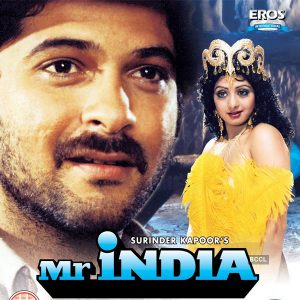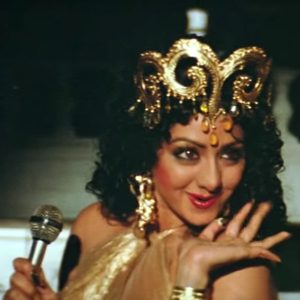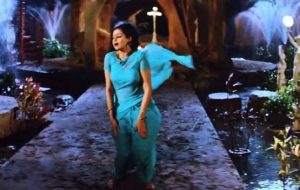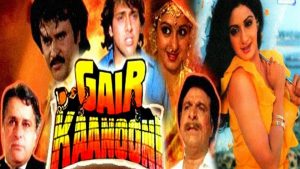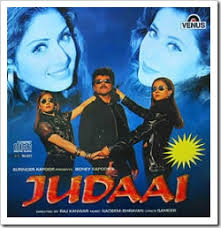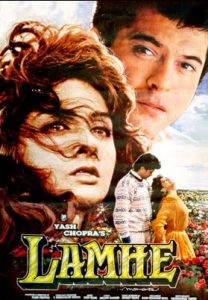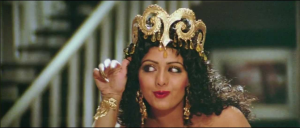
Can Sridevi, as an actress of unique merit, offer readings of some of her films with an underpinning of feminist streaks within a patriarchal world? This question arose in my mind only after her sudden demise and the satellite channels were flush with clips from her many films, song sequences, and comic scenes. One wonders why this point of view did not strike me at all when she was alive. I was, of course, aware of the massive volume of work she had produced, and fascinated, especially with English Vinglish, a film that marked her dramatic return to films after 1997. This occurred towards the end of her career, now suddenly nipped in the bud after her sudden death.
Granted that as a star, Sridevi’s audience-pulling power was almost solely determined by the box office success of her films across the languages she worked in. Granted that her image was firmly rooted in glamour and chutzpah and song and dance and romance in almost every film. Granted that her directors used her sex appeal with both intelligence and right business instinct. Granted also that her performance had the solid support of excellent actors and a supporting cast.
So, what makes her different from her peers in the industry that spans almost three generations of leading ladies?
Sridevi managed to turn her “object” position in her films into becoming the “subject” of most of her films even when the film was dominated by her male hero, and his opponents and supporters, were also mostly men.
She was bestowed the “subject” position in many films such as Chaalbaaz, Chandni, Nagina and Lamhe. She capitalised on this subject position without attempting to compromise with the glamour and the chutzpah, or even the sensual resonances of the screen image that the director and the script demanded. And yes, she came out triumphant, giving the audience enough mileage for their money, and the filmmakers their faith in her talent and her box office value to cast her in their films again and again.
Within patriarchal modes of representation through storyline, plot, characterisations, actions and message (if any) she is one actress who did not allow her performance to be dominated by the male characters, even if the narrative had given her a marginal role when compared with the male characters in the same film. In her own way, she transformed the conventional image of the heroine from the self-pitying, self-sacrificing martyr (and/or victim who extracts audience sympathy not only with tears, overly sentimental lines and a simpering demeanour) but also with some loud posturing and melodramatic dialogue-baazi.
The characters she portrayed were often designed to be conventional but she turned them into something quite different.
For example, Mr. India revolved entirely on this ordinary man who discovers the gift of invisibility by accident and learns of its power and control over people and incidents. He finds himself pitted against the stylised icon of villainy named Mocambo immortalised by Amrish Puri. Sridevi portrays an investigative journalist who is adept at quick-change disguises and in singing and dancing. She falls in love with the hero as she begins to assist him. She works under a crazy editor. In other words, the main characters are all male.
But with just a single song-dance number and her comic twists of dialogue, facial expressions that could turn cross-eyed with charm, baby-voiced lines and terrible hair-dos, she manages to steal the scene from one and all with that single number Kehte Hai Mujhko Hawai Hawaii.
In the same film, we see her in a very seductive dance number to the duet Kaate Nahin Katte Din ya Raat that almost graphically displays physical desire through a beautiful orchestrating of the scene. She dances with wild abandon, her sensuality on show, dressed in a turquoise blue sari and blouse, getting wet under the artificial fountains, in a dream scene. Yet, there is nothing vulgar about this dance.
She sizzled without really trying to, and proved that the sari can be as sexy as any other apparel that shows a lot of skin. In fact, one does not recall Sridevi as a skin-show specialist though she could carry every kind of costume, most of them a fashion designer’s nightmare today, with equal élan.
As the angry and avenging snake-woman in Nagina, where she dominates the narrative and the cinematographic space, she dances to express fiery anger, twisting and turning in a figure-hugging gold lame dance costume.
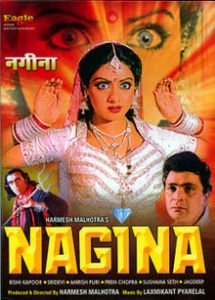
She does that classic number Main Teri Dushman Dushman Tu Mera sizzling the screen with the fire in her blue-lensed eyes. Never before or after Nagina has anyone seen a snake woman on screen who could change into any shape like Sridevi did with her screen magic, her sensuality and her performance.
Sridevi is also one of the first actresses to portray an adulterous wife in Suhaagan.
She is ironically called Janaki in the film. Janaki is another name of Sita. But she is a selfish elder daughter of parents who dotes on her. She lazes around the house because she has studied in the city while her younger sister Jyoti works the whole day. When she is married off to a simple farmer Ram Babu, she soon tires of marriage and motherhood, neglects her child and is not bothered when her husband pulls her up and looks after the baby himself. She then elopes with another city-bred man Murli and begins to live with him.
The end, of course, is a tearful melodrama to keep a patriarchal audience happy. So, a repentant Janaki comes back to her husband who is now married to her younger sister. She dies in her husband’s house because adultery in those days was not an acceptable subject and a married man cannot take back a wife who deserted him to live with another man.
Most of her films quite lucidly lay out the different ways in which (a) she resisted patriarchy, (b) constructed a distinct identity within the character she portrayed, (c) asserted her rights, and (d) contested the hierarchical arrangement of societal relationships between the sexes. Most of her dance numbers, with or without the hero, are classic examples of this truth. In a film called Gair Kanooni (which did not do good business), she plays a con-woman who is often disturbed by the fact that her parents had abandoned her at birth and her adoptive parents are bent on making her earn money by any means.
She has a famous song sequence that goes Jaylakshmi Jaylakshmi where we see her posing as the Goddess Lakshmi right in front of the idol of Lakshmi in a temple. But her leg begins to itch and one must see how she collects the booty and runs away from the seat!
This was a badly made film dominated almost entirely by Kader Khan who wrote the dialogues, but, in spite of actors like Shashi Kapoor, Govinda and Aruna Irani, one will only remember this wonderful comic scene done by Sridevi.
Judaai is a film in which Sridevi played a negative role from beginning to end. She is an extremely greedy woman lusting after riches and affluence so much that she offers to sell her own husband to the rich woman who wishes to marry him in spite of him being a married man with two kids.
This runs in complete contrast to the traditional image of the married woman who, even if she is negatively portrayed, does not go to the extent of selling her husband for Rs. 2 crores.
The film ends on a conventional note with the wife realising her mistake after having lost her husband and children. But the fact remains that the film turned out to be a very big box office hit though Sridevi played an entirely negative role in a very unrealistic and melodramatic film.
It is interesting that the infinite range of the characters she portrayed in most of her 300 films do not quite fit into the three important criteria for identifying a feminist. What are these three criteria? One, it includes women and men who have exhibited consciousness of injustice towards women as a group either by men and/or women, religion, or by customs; two, it includes those who have articulated their dissent through word and/or deed either individually or collectively; three, it is presumed that men and women engage themselves in confrontational and non-confrontations strategies either individually or collectively to improve the disadvantaged status of the female sex.
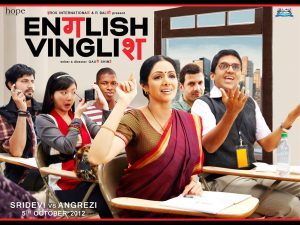
Except English-Vinglish, her glorious comeback film after 15 years away from the lights and camera and glamour, one cannot quite recall Sridevi fitting into the above criteria. This film, directed, scripted and written by a young woman director Gauri Shinde, is one of the strongest feminist statements in recent Bollywood cinema and the most power-packed performance by an actress who had kept away from the large screen of her own volition for one and a half decade.
English-Vinglish takes serious pot-shots at the patriarchal marginalisation of an ordinary woman though she is a self-respecting earning woman. The film shows how the protagonist, Shashi Godbole (Sridevi) earns a comfortable income through her indigenous business of laddus. In the US, she gets a big ego-boost when her English teacher calls her an entrepreneur. But, back home, she is made the butt of jokes by her husband and her growing daughter because she cannot speak English fluently. Her husband has the gumption to tell her to give up her laddu business and she stares back at him and asks “why”? The conventional compromise comes when we see her taking pains to learn spoken English very clandestinely but this can be seen as also a step towards self-improvement that will lead her to a life of dignity.
In Lamhe, the younger girl Pooja makes no bones about having fallen in love with Viren (Anil Kapoor) who is almost twice her age. Her dance of rage in the film performed only to music is an eloquently beautiful expression of her anger, desperation and frustration as the camera often cuts into the dance to the moment when Viren slapped her for confessing that she was in love with him and that he was still haunted by the image of his earlier love Pallavi also played by Sridevi who is dead and one cannot go on loving a dead woman.
No Indian leading lady has been paired opposite so many top heroes of Hindi, Tamil, Telugu and Malayalam cinema the way Sridevi has. The fact that many of them readily paired off with her in one film after the next, over three generations shows that her talent.
Her way of manipulating the audience towards her character in most of the films or, pairing off extremely well with different heroes of different language groups, defines another facet of her power as an actress who took her stardom, its glamour and associated frills as agencies to ensure her position as one of the most powerful actresses Indian cinema has ever produced.

